Fig. 6.05 shows a metal rod PQ resting on the smooth rails AB and positioned between the poles of a permanent magnet. The rails, the rod, and the magnetic field are in three mutual perpendicular directions. A galvanometer G connects the rails through a switch K. Length of the rod = 15 cm, B = 0.50 T, resistance of the closed loop containing the rod = 9.0mΩ. Assume the field to be uniform.
(a) Suppose K is open and the rod is moved with a speed of 12cms−1 in the direction shown. Give the polarity and magnitude of the induced emf.
(b) Is there an excess charge built up at the ends of the rods when K is open ? What if K is closed ?
(c) With K open and the rod moving uniformly, there is no net force on the electrons in the rod PQ even though they do experience magnetic force due to the motion of the rod. Explain.
(d) What is the retarding force on the rod when'K is closed ?
(e) How much power is required (by an external agent) to keep the rod moving at the same speed (=12cms−1) when Kis closed ? How much power is required when K is open ?
(f) How much power is dissipated as heat in the closed circuit? What is the source of this power?
(g) What is the induced emf in the moving rod if the magnetic field is parallel to the rails instead of being perpendicular?
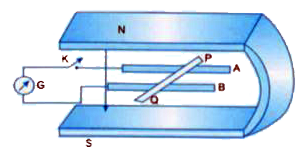
(a) ∣∣ɛ∣∣=Blvsinθ.
Here θ=90∘,l=15cm=0.15m,B=0.50Tandv=12cms−1
Therefore, lvarεlol=Blv=0.50×0.15×0.12=9.0×10−3V=9.0mV
Using left hand rule, the Lorentz.s force on electron is from P to rendering end P positive and end Q at negative potential.
(b) Yes, an excess charge is build up at the ends of the rod when K is open, because of the induced emf set up between the ends. When K is closed, the excess charge is maintained by the continuous flow of current due to induced emf.
(c) The magnetic force −e(→v×→B) is balanced by the electric force −e→E. The electric force is set up due to the excess charges of opposite signs between the ends of the rod.
(d) When K is closed the retarding force on the rod is
F=BIl=B×ɛR×l,andR=9.0mΩ=9.0×10−3Ω
∴ The power required =Fv=7.5×10−2×10−3W
The power dissipated =varεlo2R=(9.0×10−3)29.0×10−39.0×10−3W
The power is provided by the external agent supplying power.
Since, ∣∣ɛ∣∣=Blvsinθandθ in this case 0∘, therefore the induced emf is zero.
Topper's Solved these Questions
- ELECTROMAGNETICE INDUCTIONBOOK - U-LIKE SERIESCHAPTER - ELECTROMAGNETICE INDUCTIONEXERCISE - Case Based/Source-Based Integrated Questions
3 Videos
- ELECTROMAGNETICE INDUCTIONBOOK - U-LIKE SERIESCHAPTER - ELECTROMAGNETICE INDUCTIONEXERCISE - Multiple Choice Questions
30 Videos
- ELECTROMAGNETICE INDUCTIONBOOK - U-LIKE SERIESCHAPTER - ELECTROMAGNETICE INDUCTIONEXERCISE - Self Assessment Test Section -D
1 Videos
- ELECTROMAGNETIC WAVESBOOK - U-LIKE SERIESCHAPTER - ELECTROMAGNETIC WAVESEXERCISE - SELF ASSESSMENT TEST (SECTION C)
1 Videos
- ELECTROSTATIC POTENTIAL AND CAPACITANCE BOOK - U-LIKE SERIESCHAPTER - ELECTROSTATIC POTENTIAL AND CAPACITANCE EXERCISE - SELF ASSESSMENT TEST
1 Videos
Similar Questions
Magnetic flux ϕB through a plane of area 'A' placed in a uniform magnetic field vceB is given as:
ϕB=vceB.vceA=BAcosθ
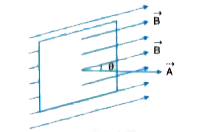
where θ is the angle between vceB and vceA. The above relatio can be extended to curved surfaces and non-uniform fields. In general, if the magnetic field has different magnitudes an directions at various parts of a surface, then the magnetic flux through the surface is given by
ϕB=∫→B.d→A
On the basis of the experimental observations, Faraday concluded that an emf is induced in a coil when magnetic flux through the coil changes with time. Faraday stated his conclusions in the form of a law called Faraday's law of electromagnetic induction. As per this law, the induced emf is given by
ɛ=−dϕBdt
The negative sign in the expression indicates the direction of induced emfe and hence the direction of current in a closed loop.
In the case of a closely would coil of N turns, change of flux associated with each turns is the same and so that total induced emf is given by ɛ=−NdϕBdt
From above relations it is clear that the magnetic flux can be changed by changing any one or more of the terms vceB,vceAandθ.
(a) Give SI unit of magnetic flux.
(b) How is it related to tesla ?
(c) Obtain dimensional formula of magnetic flux.
(d) A loop of area 4×10−3m2 is placed with its plane perpendicular to a uniform magnetic field of 0.02 T. If the loop is quickly removed from the magnetic field within a time of 2 ms, what is the magnitude of induced emf across the two ends of the loop ?
(e) If the resistance of the loop be 0.2Ω and a sensitive milliammeter be connected between the two ends of loop, what will be the reading of milliammeter?
View SolutionA square of side L metre lies in the x - y plane in a region, where the magnetic field is given by →B=B0(2ˆi+3ˆj+4ˆk)T, where B0, is constant. The magnitude of flux passing through the square is [Exemplar Problem]
View Solution(a) Derive the expression for the magnetic energy stored in an inductor when a current I develops in it. Hence, obtain the expression for the magnetic energy density.
(b) A square loop of sides 5 cm carrying a current of 0.2 A in the clockwise direction is placed at a distance of 10 cm from an infinitely long wire carrying a current of 1 A as shown in Fig. 6.66. Calculate (i) the resultant magnetic force, and (ii) the torque, if any, acting on the loop.
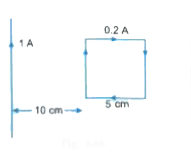
View SolutionSuppose that the electric field amplitude of an electromagnetic wave is E0=120N/C and that its frequency is v=50.0MHz.
(a) Determine B0,ω,kandλ
(b) Find expressions for →Eand→B.
View SolutionThree capacitors of a capacitances 3μF,9μF and 18μF are connected initially in series and subsequently in parallel . The ratio of equivalent capacitance in the two cases (CsCp) will be
View SolutionFollowing figure shows a metal rod PQ resting on the smooth ralls AH and positioned between the poles of a permanent magnet. The rails, the rod and the magnetic field are in three mutual perpendicular directions. A galvanometer G connects the rails through a switch K. Length of the rod 15 cm, B 0.50 T, resistance of the closed loop containing the rod 9.0 mOmega . Assume the field to be uniform. Suppose K is open and the rod is moved with a speed of 12"cm s"^(-1) in the direction shown. Give the polarity and magnitude of the induced emf.
View SolutionFollowing figure shows a metal rod PQ resting on the smooth ralls AH and positioned between the poles of a permanent magnet. The rails, the rod and the magnetic field are in three mutual perpendicular directions. A galvanometer G connects the rails through a switch K. Length of the rod 15 cm, B 0.50 T, resistance of the closed loop containing the rod 9.0mΩ. Assume the field to be uniform.
Is there an excess charge built up at the ends of the rods when K is open? What if K is closed?
View SolutionFollowing figure shows a metal rod PQ resting on the smooth ralls AH and positioned between the poles of a permanent magnet. The rails, the rod and the magnetic field are in three mutual perpendicular directions. A galvanometer G connects the rails through a switch K. Length of the rod 15 cm, B 0.50 T, resistance of the closed loop containing the rod 9.0 mOmega . Assume the field to be uniform. With K open and the rod moving uniformly, there is no net force on the electrons in the rod PQ even though they do experience magnetic force due to the motion of the rod. Explain.
View SolutionFollowing figure shows a metal rod PQ resting on the smooth ralls AH and positioned between the poles of a permanent magnet. The rails, the rod and the magnetic field are in three mutual perpendicular directions. A galvanometer G connects the rails through a switch K. Length of the rod 15 cm, B 0.50 T, resistance of the closed loop containing the rod 9.0 mOmega . Assume the field to be uniform. What is the retarding force on the rod when K is closed?
View SolutionFollowing figure shows a metal rod PQ resting on the smooth ralls AH and positioned between the poles of a permanent magnet. The rails, the rod and the magnetic field are in three mutual perpendicular directions. A galvanometer G connects the rails through a switch K. Length of the rod 15 cm, B 0.50 T, resistance of the closed loop containing the rod 9.0mΩ. Assume the field to be uniform.
How much power is required (by an external agent) to keep the rod moving at the same speed (=12 cm s−1) when K is closed ? How much power is required when K is open?
View SolutionFollowing figure shows a metal rod PQ resting on the smooth ralls AH and positioned between the poles of a permanent magnet. The rails, the rod and the magnetic field are in three mutual perpendicular directions. A galvanometer G connects the rails through a switch K. Length of the rod 15 cm, B 0.50 T, resistance of the closed loop containing the rod 9.0mΩ. Assume the field to be uniform.
How much power is dissipated as heat in the closed circuit ? What is source of this power?
View SolutionFollowing figure shows a metal rod PQ resting on the smooth ralls AH and positioned between the poles of a permanent magnet. The rails, the rod and the magnetic field are in three mutual perpendicular directions. A galvanometer G connects the rails through a switch K. Length of the rod 15 cm, B 0.50 T, resistance of the closed loop containing the rod 9.0mΩ. Assume the field to be uniform.
What is the induced emf in the moving rod if the magnetic field is parallel to the rails instead of being perpendicular?
View Solutionचित्र में एक धातु की छड़ PQ को दर्शाया गया है जो पटरियों AB पर रखी है तथा एक स्थायी चुम्बक के ध्रुवो के मध्य स्थित है । पटरियाँ , छड़ एवं चुंबकीय क्षेत्र परस्पर अभिलंबवत दिशाओ में है ।एक गैल्वेनोमीटर ( धारामापी ) G को पटरियों से एक स्विच K की सहायता से संयोजित किया गया है । छड़ की लम्बाई 15 सेमी , B = 0.50 T तथा पटरियों , छड़ धारामापी से बने बंद लूप का प्रतिरोध = 9.0mΩ है । क्षेत्र को एकसमान मान ले ।
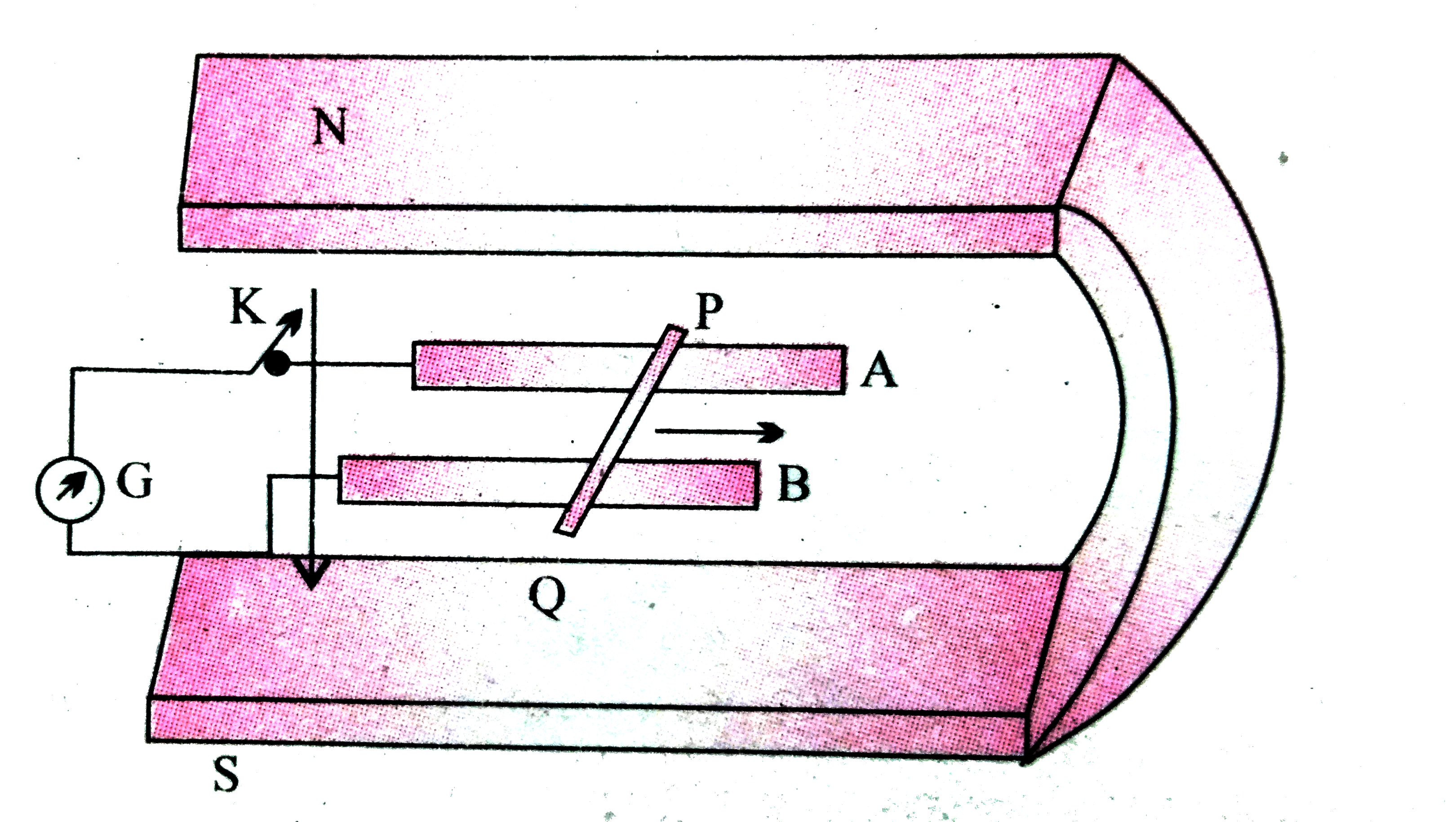
क्या कुंजी K खुली होने पर छड़ के सिरों पर आवेश का आधिक्य हो जायेगा ? क्या होगा यदि कुंजी K बंद कर दी जाए ?
View Solutionचित्र में एक धातु की छड़ PQ को दर्शाया गया है जो पटरियों AB पर रखी है तथा एक स्थायी चुम्बक के ध्रुवो के मध्य स्थित है । पटरियाँ , छड़ एवं चुंबकीय क्षेत्र परस्पर अभिलंबवत दिशाओ में है ।एक गैल्वेनोमीटर ( धारामापी ) G को पटरियों से एक स्विच K की सहायता से संयोजित किया गया है । छड़ की लम्बाई 15 सेमी , B = 0.50 T तथा पटरियों , छड़ धारामापी से बने बंद लूप का प्रतिरोध = 9.0mΩ है । क्षेत्र को एकसमान मान ले ।
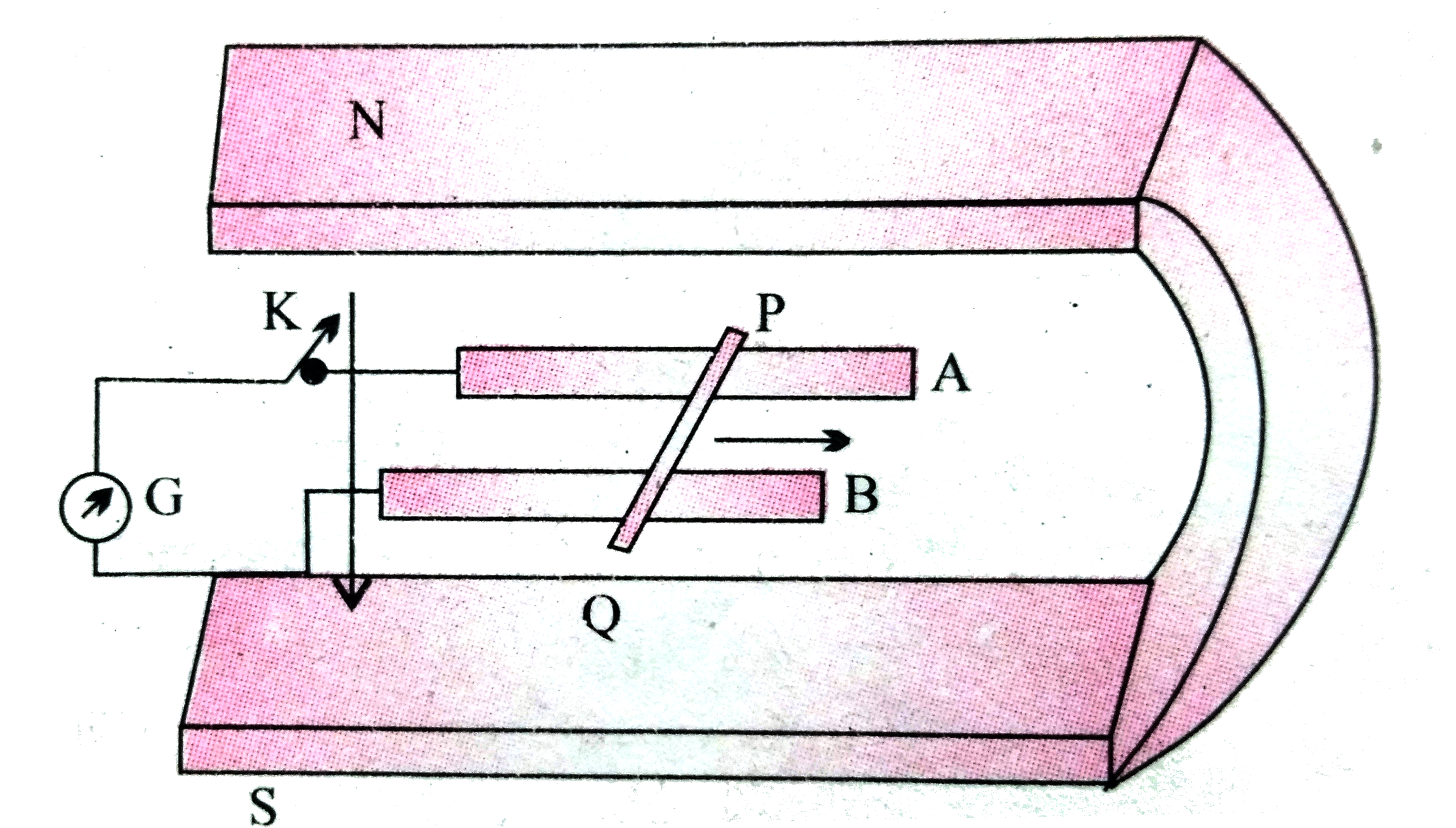
कुंजी बंद है तथा छड़ 12 सेमी /से की चाल से दर्शायी गयी दिशा में गतिमान होने की स्थिति में छड़ पर लगने वाले अवमंदन बल का मान क्या होगा ?
View SolutionA metal rod PQ is resting on the rails A'B' and positioned between the poles of a permanent magnet. The rails, the rod and the magnetic field are in three mutually perpendicular directions. A galvanometer G connects the rails through a switch K. Length of the rod = 15 cm, B = 0.50 T, resistance of the closed loop containing the rod = 9.0 mOmega . Assume the field to be uniform. Suppose K is open and the rod is moved with a speed of 12 cm. s^(-1) in the direction shown. Give the polarity and magnitude of the induced emf.
View SolutionA metal rod PQ is resting on the rails A'B' and positioned between the poles of a permanent magnet. The rails, the rod and the magnetic field are in three mutually perpendicular directions. A galvanometer G connects the rails through a switch K. Length of the rod = 15 cm, B = 0.50 T, resistance of the closed loop containing the rod = 9.0 mOmega . Assume the field to be uniform. Is there an excess charge built up at the ends of the rods when K is open? What if K is closed?
View Solution
